How to Summarize an Article [4 AI-Assisted Methods]
Summary :
This page covers the skills and steps for summarizing articles and demonstrates how to use AI assistants for efficient summarization.
Table of Contents
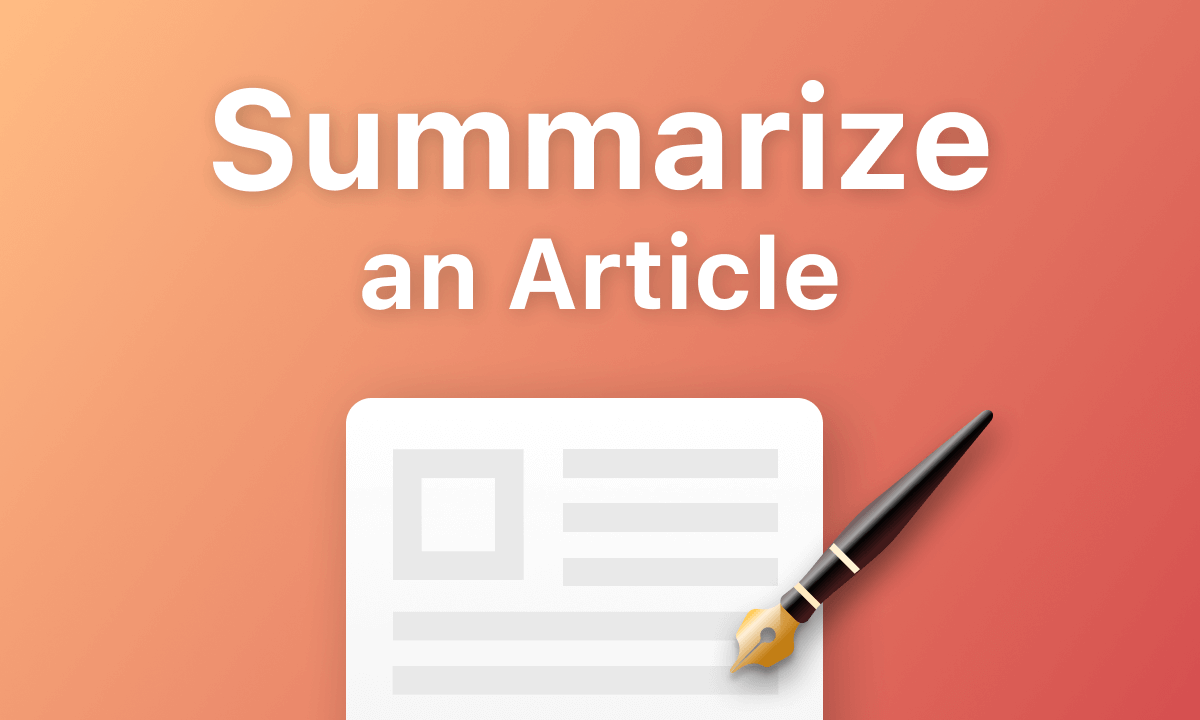
How to Summarize an Article
When you read an article, a summary quickly provides the central theme, key data, and conclusions. If you need to write a summary, the following tips will help.
With advancements in AI, you can save time and effort by using AI to generate accurate summaries. Read on for steps to use an AI assistant effectively.
What is Summary
An article summary is an overview of the article’s core information, main ideas, key details, and important conclusions.
Summaries are primarily divided into two forms: extractive summarization and abstractive summarization.
Extractive summarization compiles coherent and concise paragraphs by selecting fragments of text that express the main ideas in the original text. This method is easy to implement and retains the original language and wording. Still, it may lack coherence and logical flow, and it can miss the overall context and subtle meanings.
On the other hand, abstractive summarization requires a deep understanding of the main ideas and themes of the original text to regenerate new sentences that convey the essence of the original text. This method is more coherent and concise, captures the spirit of the text, and may be more readable. However, it is more complicated to implement and carries a higher risk of inaccuracy if readers misunderstand the original content.
How to Summarize an Article: Skills and Steps
It is not easy to summarize an article, especially a long article, and the whole process will be very time-consuming. Generally, we need to understand the author and the background of the article first, read the article at least three times, and then summarize the article based on some notes we added.
But the following tips can save you some time.
Step 1. Know the Author and the Background/Writing Scene
It is very important to know the author of an article, which can give you an idea of the style and tone of that article. Secondly, the background of the times or a specific writing background will also directly affect your emotional judgment and the main purpose of the entire article.
Step 2. First Reading
Read the first and last paragraphs because these two paragraphs will give you an idea of what this article is about. Second, read the first paragraph of each section so that you can identify exactly what each section is about. Finally, read the full text.
Step 3. Second Reading
Read the full text carefully and mark the sentences that you don’t understand. And summarize the main content of each part. At the same time, record your doubts in the blank space.
Step 4. Third Reading
Spot the sentences you don’t understand. Then concatenate the keywords you marked with the summary of each part, and answer the questions you asked to determine a rough summary.
Step 5. Summarize the Article
Organize the summary to clarify the key points and condense the content. Follow the outline below to structure your summary effectively:
- Introduction: Briefly introduce the article’s title and author. State the main purpose or objective of the article.
- Background: Provide context or background information relevant to the article’s topic.
- Purpose: Clearly state the research focus, scope, and purpose of the article.
- Methods: Describe the methods, theories, data, and models used in the research.
- Results: Summarize the main findings, statistics, and metrics from the study, or the main ideas and positions the author wants to express.
- Conclusion: For research articles, mention any potential applications or future directions suggested by the article. For literary articles, mention the author’s prospects and subsequent impact.
Use this outline to create a comprehensive and well-structured summary of any article.
Therefore, it will take you at least several hours to successfully write an abstract of an article. If the article is difficult and long, you may even spend a few days or half a month on research.
However, if you use the assistance of AI tools, you will achieve twice the result with half the effort. Moreover, some AI tools support the understanding and generation of multilingual content, so you don’t have to worry about the trouble of understanding caused by language.
Summarize an Article Using AI for Free
PDFgear’s Chat with PDF feature allows you to let the artificial intelligence tools in the program help you to do a quick browse and remember. You can use PDFgear Copilot to ask questions, locate, or summarize for free.
Step 1. Install PDFgear Copilot
You can download PDFgear Copilot on your device through the official website or click the following button. PDFgear is compatible with Windows, macOS, and iOS.
PDFgear enhances summarizing speed with its AI assistant. With the help of PDFgear Copilot, even lengthy articles can be summarized in just a few seconds.
Step 2. Import Article to PDFgear
Open PDFgear > Click “Open File” on the left > Select the local files in the device to import.
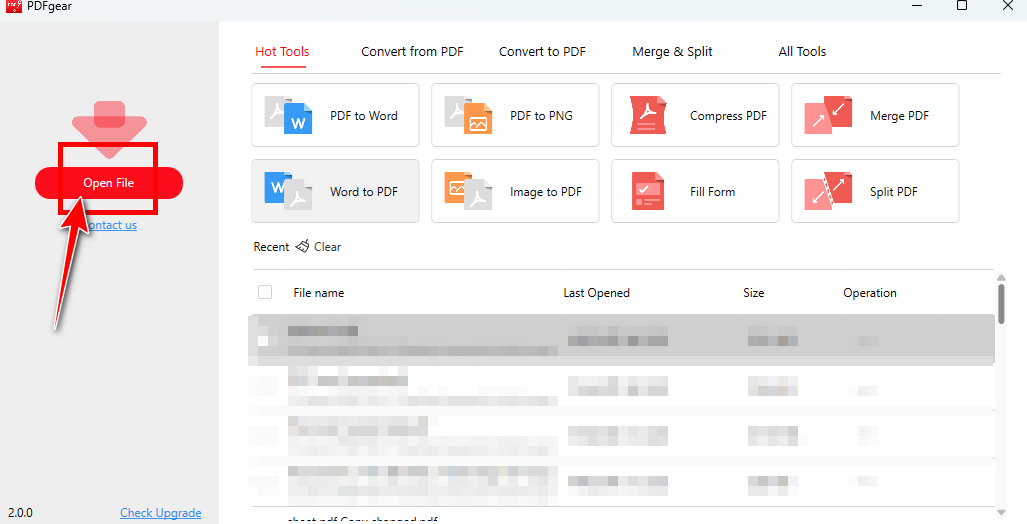
Upload File to PDFgear
Step 3. Summarize an Article in PDFgear Copilot
Click the “Chat Now” button > Click the preset questions: “Summarize this PDF file” > Get the summary in seconds.
Alternatively, you can type your command in the input box and send it to get a summary.
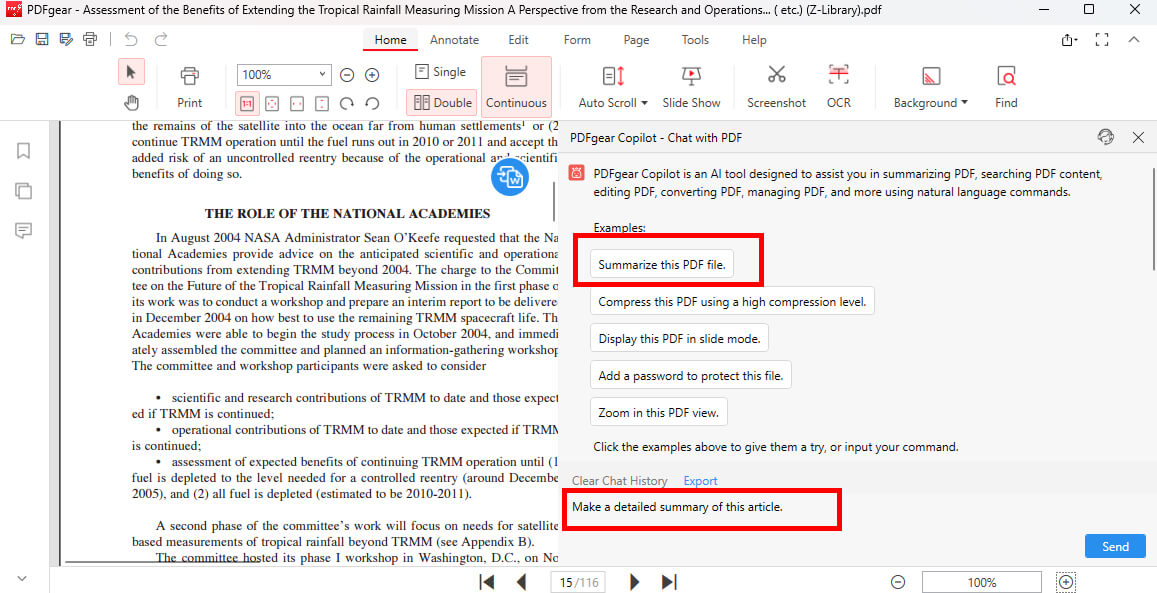
Get the Article Summary from PDFgear Chatbot
Furthermore, adding annotations or comments is quick and easy with PDFgear. To emphasize keywords or important content, you can use the highlight, line, and shape tools. After reading the entire article with the help of PDFgear Copilot, you can insert a stamp to reflect your progress.
You can edit your PDF while using PDFgear’s Copilot feature.
Furthermore, PDFgear Copilot also provides you with a very surprising function. Send command operation to PDFgear Copilot > Conform the command > You will be taken to the function interface you desire.
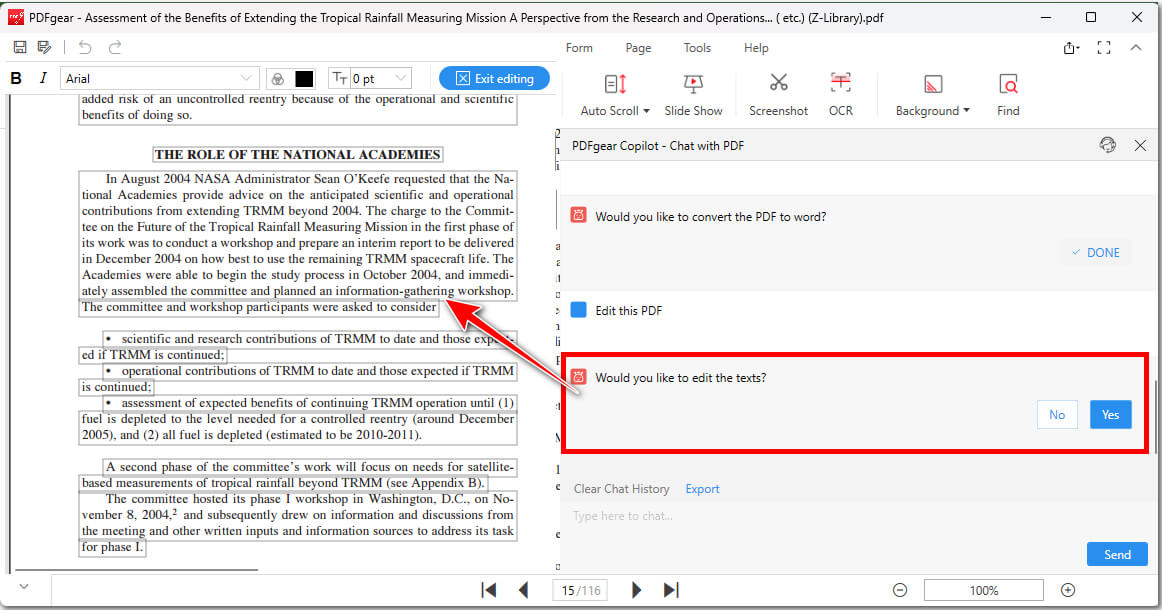
Go to the Function Interface Using AI
How to Summarize an Article Using ChatPDF
ChatPDF is a PDF management and finding tool with a smart Q&A feature as one of its highlights. By combining with OpenAI’s GPT-3 technology, ChatPDF can help you quickly parse the contents of the PDF files you uploaded and find the answer after you ask a question.
The multi-language support feature is also favored by users.
Step 1. You can type chatpdf.com in your browser to go directly to its homepage and import the PDF files by dragging and dropping using your mouse.
Alternatively, ChatPDF provides you with multiple file upload options. Give them a shot!
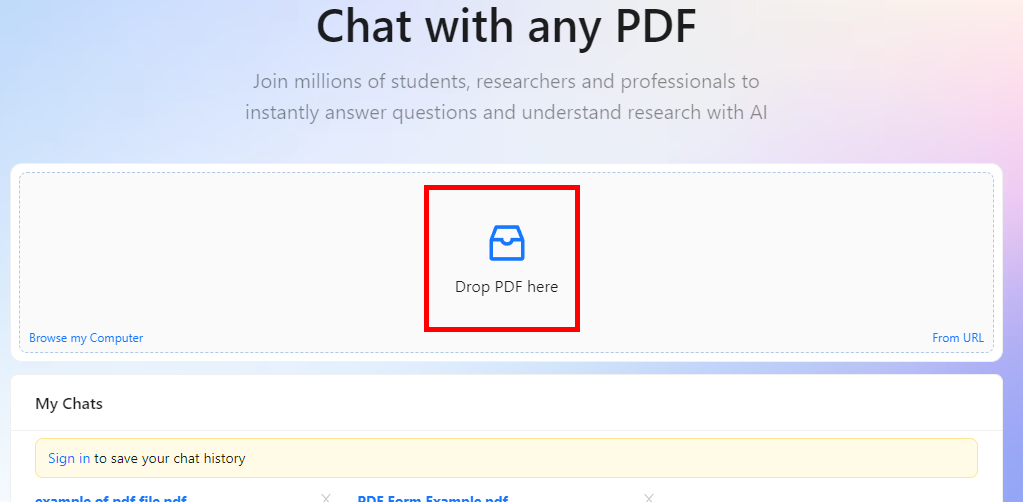
Drop Your PDF File to ChatPDF
Step 2. When you enter the main ChatPDF session page, you can receive a brief article summary and sample questions.
Or, you can enter your question in the dialog box below and send it to get a detailed article summary.
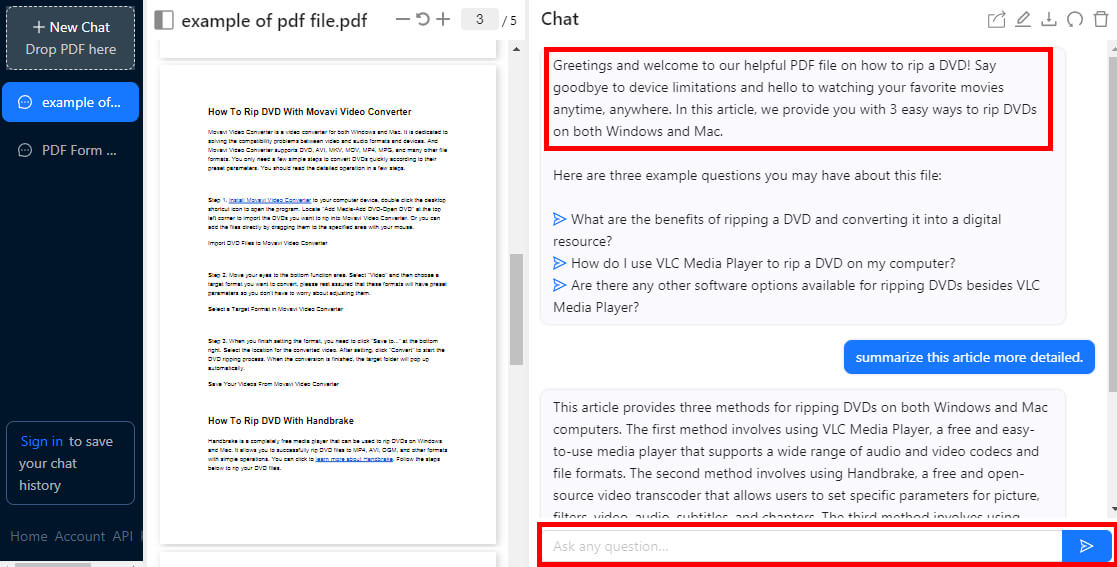
Summarize an Article in ChatPDF
How to Summarize an Article With TLDR This
TLDR This is available to anyone who is off the grid. No matter what field you work for, once you need to summarize long articles, you can access the service on TLDR’s website.
Through AI-only analysis, it provides an automatic summarization solution for all netizens. What’s commendable is that you won’t see any advertising pop-ups or marketing distractions on TLDR’s webpage. So you can be focused when using it.
Step 1. You can see a tutorial video when you enter the TLDR website, so you don’t have to worry that you can’t understand the logic of the operation.

Enter the TLDR Official Site
Step 2. There are two ways to upload the file:
👉Paste the URL of the article, which is great for online documents or web articles.
👉Copy and paste the article content directly from your local document into the TLDR text box to complete the upload.
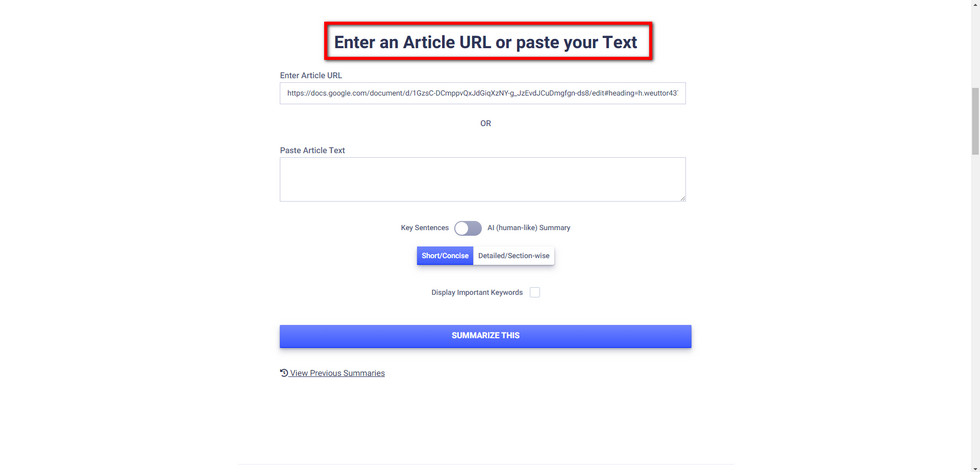
Add Article to TLDR
Step 3. Click the “SUMMARIZE THIS” button, and you will be automatically redirected to “SUMMARY” after the gear icon finishes turning.
If you checked the “Display Important Keywords” box before, then you can also see the keywords displayed in the summary.
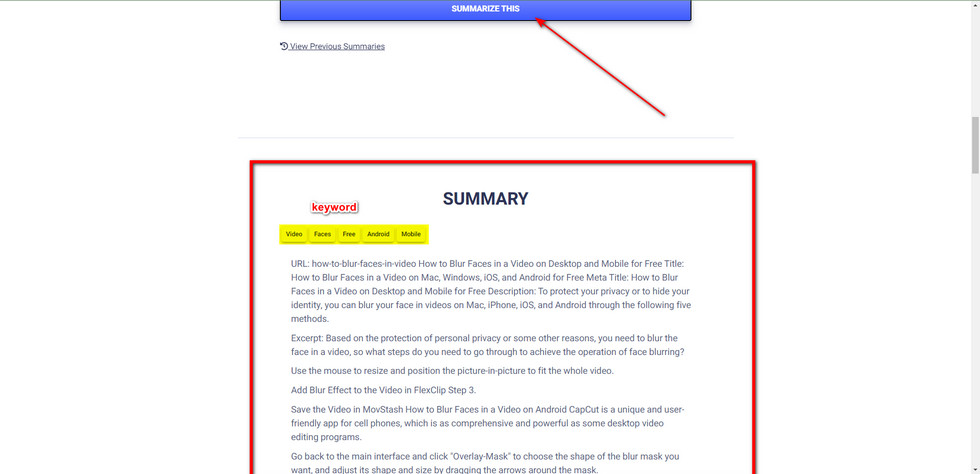
Use TLDR to Summarize an Article
How to Summarize an Article on ChatGPT
ChatGPT is an artificial intelligence chat program launched by OpenAI in November 2022. It has quickly evolved from GPT-2 to GPT-4 within a few months. Now, GPT-4o, a more powerful and quick-feedback AI tool, has arrived in our lives.
It has demonstrated powerful functionality in reading summaries, conversations, writing, story generation, role-playing, and more. Therefore, it is easy to generate a summary for your article with ChatGPT.
Step 1. Get an account for ChatGPT > Log in and create a new session.

Enter ChatGPT Chat Room
Step 2. Upload the article to ChatGPT either in file format or link format. Type the command “Summarize this article” to get a quick response.
However, you only have 10 tokens if you are not subscribed. To become a subscriber, pay $20 per month.

Type Your Requirement and Get a Summary
FAQs
Can I summarize a PDF in a few seconds?
It takes much time to read and summarize an article even for fast readers. Fortunately, with the help of an AI program, you can make a summary quickly. PDFgear Copilot provides you with a quick and free solution.
What to avoid when writing a summary?
Do not bring in your own position; remain neutral, and do not comment on the views expressed in the article.
Avoid plagiarism by not using the original sentences word for word. Indicate the source when quoting.
Do not go into unnecessary details, and do not include irrelevant factors, as this will make the summary long and complicated.
Do not ignore the key points. Omitting key information will result in the summary failing to clearly convey the full text’s arguments or other relevant information.
How to summarize a journal article?
To summarize a journal article, read the entire article to understand its main points and structure. Identify key sections: introduction (research question, objectives), methods (research design), results (key findings), and conclusion (interpretation, implications). Highlight the most important information from each section. Write a draft with a brief introduction (title, author, purpose), and concisely summarize each section in your own words, avoiding plagiarism and crediting any direct quotes. Review and revise for clarity and conciseness, ensuring all essential points are included.
Keep the summary between 150-250 words, providing a comprehensive overview without personal opinions or unnecessary details.
Conclusion
Summarizing an article is a time and energy-consuming task, so if you can work well with AI, you will do your job efficiently. The above four tools were all launched with paid versions except PDFgear.
So if you do not want to pay any subscription fee to get a free and unlimited experience, then PDFgear will be a good choice.
